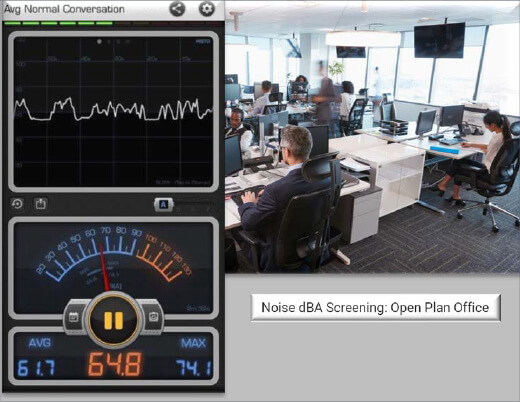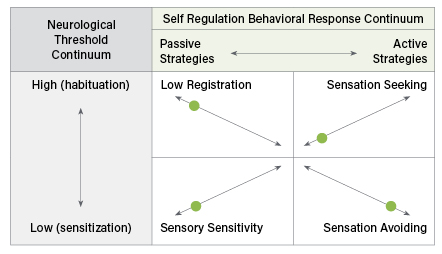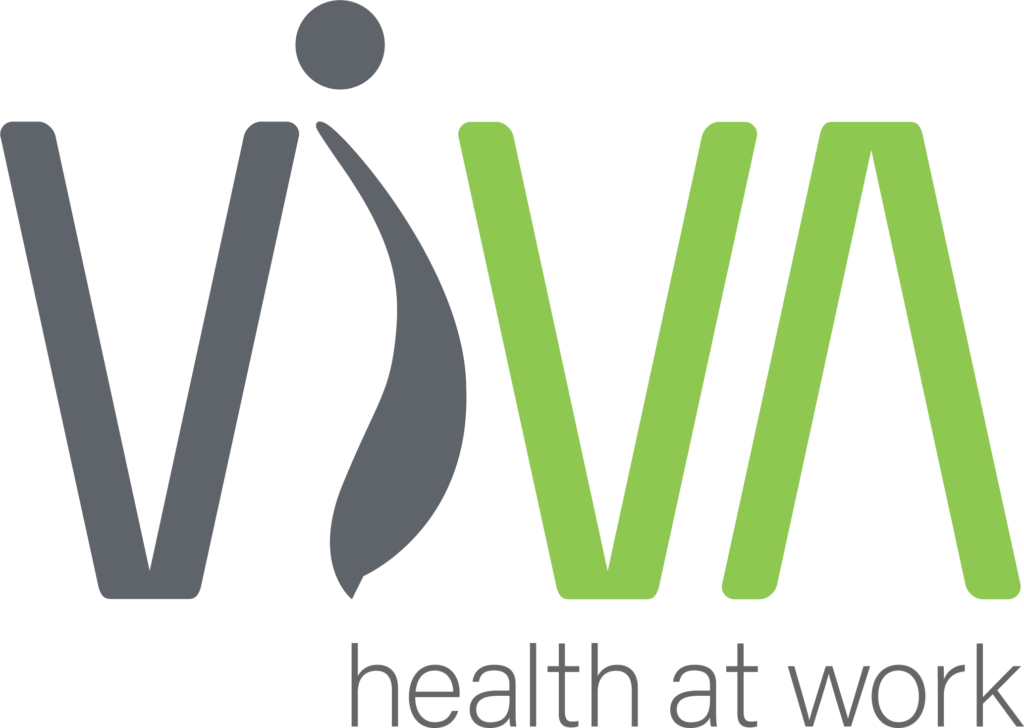A referral request was received owing to complaint of office noise following a worker complaint of distractions in an open-plan office environment. Upon further investigation, the ergonomist advised an assessment of the individual and their sensory processing profile combined with gross environmental screening of noise, examination of other sensory stimuli within the work environment, productivity indices review, and analysis of job demands to inform strategies for work design and early intervention.

INDOOR ENVIRONMENTAL QUALITY | SENSORY PROCESSING | EARLY INTERVENTION | AS/NZS 2107: 2016
DESIGN STRATEGIES
- Worker accommodation
- Environmental work design: e.g., sound absorbent walls, ceilings, and flooring; sound masking; glare reduction; activity delineation; and agile work design.
Methods
The following activities were undertaken:
- Pre-site visit:
- Distribution and administration of a self-rated questionnaire, The Adolescent / Adult Sensory Profile (AASP),i a standardised assessment with normative data, to assess the worker.
- The investigator scored findings prior to the visit.
- On-site visit:
- A meeting was held with the line supervisor to determine the background to this referral and learn about the contextualised workplace culture.
- Skilled interview was undertaken with the worker and findings of the AASP questionnaire were reviewed to verify, qualify, and validate the information and scoring. The interview included a review of history of complaint and relevant symptoms; identification of perceived performance capability and restrictions; review of job role, task demands, and productivity needs; collaborative ideas-generation for design intervention; motivational interviewing regarding perceived likelihood to implement effective change strategies; and investigation of other issues of concern.
- Noise meter environmental screening using the dB10 noise meter and spectrum analyser smart-phone application of the natural environment and simulated conversational climate in several possible work areas. The frequency weighting for sound pressure recording was set to “A” (dBA), or a level that is considered akin to human hearing and that is less sensitive to very high or very low frequencies.
- Productivity Index screening (intelligibility of the spoken word as a percentage) was conducted in several work areas.
- A meeting was held to present the findings and to discuss practical design strategies.
- Post site-visit:
- Review of documentation: receipt of medical information supplied post-visit (not available pre-visit).
- Further synthesis of literature and design strategies.
- Reporting and a phone discussion with management to explain the findings and discuss recommendations.
Key Findings
Key findings included:
- Job role: demanding of cognitive processes to code, provide quality assurance, diagnose programming faults, and design systems or system improvements. Effective work practice was considered to require regular and spontaneous interaction with others for problem-solving and systems design.
- Verification of the worker’s sensory profile: low neurological threshold and a low registration (ability to discriminate) of auditory stimuli (less than 2% of the normative sample). Also, the worker had high levels of sensitivity to sensation (much more than most people, findings consistent with less than 2% of the normative population sample) for auditory, visual, thermal, and touch stimuli, low levels of sensation seeking (much less than most people, findings consistent with less than 2% of the normative population sample), and high levels of sensation avoidance behaviours (much more than most people, findings consistent with less than 2% of the normative population sample).

- Environmental noise above the design standards for recommended noise levels screening measures were <50 to 70dBA max, or just below average conversation to street noise of local traffic (advised: 40 – 45 (LAeq.t equivalent to dBA per AS/NZS 2107:2016).ii
- Productivity Index: (audible, intelligible spoken word in neighbouring work areas): 80 – 85% (“normal privacy” but not “confidential”).iii
![Images 2-5[vi]: Agile work-design at Medibank Private Docklands; webinar with Green Building Council of Australia and cited in Hedge & Pazell (2016).](https://vivahealthgroup.com.au/wp-content/uploads/Viva-Case-Study_indoor-env-quality_03.jpg)
![Images 2-5[vi]: Agile work-design at Medibank Private Docklands; webinar with Green Building Council of Australia and cited in Hedge & Pazell (2016).](https://vivahealthgroup.com.au/wp-content/uploads/Viva-Case-Study_indoor-env-quality_04.jpg)
![Images 2-5[vi]: Agile work-design at Medibank Private Docklands; webinar with Green Building Council of Australia and cited in Hedge & Pazell (2016).](https://vivahealthgroup.com.au/wp-content/uploads/Viva-Case-Study_indoor-env-quality_05.jpg)
![Images 2-5[vi]: Agile work-design at Medibank Private Docklands; webinar with Green Building Council of Australia and cited in Hedge & Pazell (2016).](https://vivahealthgroup.com.au/wp-content/uploads/Viva-Case-Study_indoor-env-quality_06.jpg)
Recommendations
Recommendations to support the worker:
- SHORT-TERM:
Provide written instructions to support; window shades, monitor repositioning, and change of fluorescent lighting with trial of amber-coloured sleeve to subdue lighting and reduce direct and reflective glare to whiteboard and screen. - MID-TERM:
Investigate the capacity to provide a solo-office or more protected and sheltered work area with less ambient noise or potential distractions, yet still provide for team interaction though scheduled and impromptu meetings including remote tech-blogs or similar forums.
Environmental Recommendations
- SHORT-TERM:
Preventative maintenance for door hinges and struts to reduce “creaking and squeaking noises” associated with door interface in hallways and office enclosures; assess air conditioning thermal settings and the scope of cooling in different work areas; recommended for human performance at 24 – 25°C.[iv] - MID-TERM:
- Suitable window treatments to block high lighting levels and glare with adjustable focal lighting in concentrated work areas
- Sound absorbent wall paint or treatments and sound-absorbent ceiling tiles or carpeting (wall, ceiling, and flooring options)
- Create distance between social gathering areas and the designated quiet work spaces
- Designated separate meeting and phone conference spaces to occur in areas away from quiet work spaces.
- LONG TERM:
- Open-plan and shared offices may be substituted with a percentage of workspace that provides for optional solo-time in areas that meet the design standard specifications of 40 – 45dbA exposures (per AS/NZS 2107:2016). For example, office pods that sit within or at the perimeter of an open-plan design work area, or a reallocation of private office spaces and functional use.
- “Cones of silence” and automated self-regulating temperature and lighting with provision of specialised individual office pods.
- Investigate sound-masking technology: e.g., acoustic network mask loudspeakers to help reduce the experience of intelligible speech.Investigate agile work design to provide for a range of human tactics, preferences, work demand, and work styles. It may provide for solo, focused, thinking space; team collaboration; human movement and low-impact physical activity; space for retreat; and space for social convergence.[v]
- Solo: focused, thinking space
- Team: collaboration, planning, meeting
- Drive: human movement and standing
- Recharge: relax and retreat
- Converge: meet, greet, dine or socialise
[i] Brown C. E. & Dunn, W. (2002). Adolescent/Adult Sensory Profile: User’s manual. San Antonio, TX: Psychological corporation.
[ii] Australian/New Zealand Standard: AS/NZS 2107: 2016: Acoustics – Recommended design sound levels and reverberation times for building interiors.
[iii] Ruth Newman (date unspecified). Acoustic Comfort. https://sourceable.net/ten-steps-to-achieve-acoustic-comfort-in-the-office/#
[iv] Cornell University (22 October 2004). “Study links warm offices to fewer typing errors and higher productivity.” ScienceDaily. https://www.sciencedaily.com/releases/2004/10/041021083103.htm
[v] Hedge, A., & Pazell, S. (2016). Chapter 21: Ergonomics and wellness in workplaces, Part 3: Emerging ergonomic workplace design issues, In Hedge, A. (Ed.). Ergonomic Workplace Design for Health, Wellness, and Productivity. CRC Press: Florida.
[vi] Hedge, A., & Pazell, S. (2016). Chapter 21: Ergonomics and wellness in workplaces, Part 3: Emerging ergonomic workplace design issues, In Hedge, A. (Ed.). Ergonomic Workplace Design for Health, Wellness, and Productivity. CRC Press: Florida.
